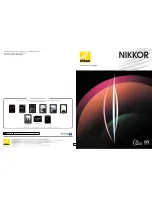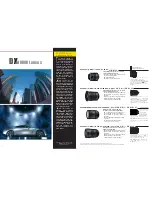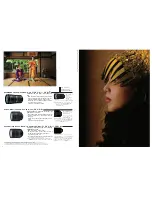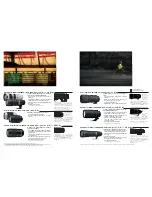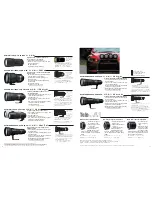
N
ikon
Technology
6
7
ED glass
—
an essential element
of NIKKOR telephoto lenses
Nikon developed ED
(Extra-low Dispersion)
glass to enable the
production of lenses
that offer superior
sharpness and colour
correction by minimising chro-
matic aberration.
Put simply, chromatic aber-
ration is a type of image
and colour dispersion that
occurs when light rays of vary-
ing wavelengths pass through
optical glass. In the past, cor-
recting this problem for tele-
photo lenses required special
optical elements that offer
anomalous dispersion charac-
teristics — specifically calcium
fluoride crystals. However, fluo-
rite easily cracks and is sensi-
tive to temperature changes
that can adversely affect focus-
ing by altering the lens’ refrac-
tive index.
So Nikon designers and
engineers put their heads
together and came up with ED
glass, which offers all the bene-
fits, yet none of the drawbacks
of calcium fluorite-based glass.
With this innovation, Nikon
developed several types of ED
glass suitable for various lenses.
They deliver stunning sharp-
ness and contrast even at
their largest apertures. In this
way, NIKKOR’s ED-series
lenses exemplify Nikon’s pre-
eminence in lens innovation
and performance.
Nikon Super
Integrated Coating
ensures exceptional
performance
To enhance the performance
of its optical lens elements,
Nikon employs an exclusive
multilayer lens coating that
helps reduce ghost and flare
to a negligible level.
Nikon Super Integrated
Coating achieves a number
of objectives, including min-
imised reflection in the wider
wavelength range and superior
colour balance and reproduc-
tion, even with Zoom-NIKKOR
lenses featuring a large num-
ber of elements. It is also effec-
tive in minimising ghost and
flare caused by internal reflec-
tions from the image sensors of
Nikon digital SLRs.
Also, Nikon's multilayer
coating process is tailored to
the design of each particular
lens. The number of coatings
applied to each lens element
is carefully calculated to
match the lens type and
glass used, and also to
assure the uniform colour bal-
ance that characterises
NIKKOR lenses. This results
in lenses that meet much
higher standards than the
rest of the industry.
Nano Crystal
Coat
Nano Crystal Coat is
an anti-reflective coat-
ing that originated in the devel-
opment of NSR-series (Nikon
Step and Repeat) semicon-
ductor manufacturing devices.
It virtually eliminates internal
lens element reflections across
a wide range of wavelengths,
and is particularly effective in
reducing ghost and flare pecu-
liar to ultra-wideangle lenses.
Nano Crystal Coat employs
multiple layers of Nikon’s out-
standing extra-low refractive
index coating, which features
ultra-fine crystallized particles
of nano size (one nanometer
equals one millionth of a mm).
Nikon now proudly marks a
world first by applying this
coating technology to a wide
range of lenses for use in con-
sumer optical products.
Aspherical lens
elements
Nikon introduced the first
photographic lens with
aspherical lens elements in
1968. What sets them apart?
Aspherical lenses virtually
eliminate the problem of
coma and other types of lens
aberration — even when
used at the widest aperture.
They are particularly useful in
correcting the distortion in
wideangle lenses. In addition,
use of aspherical lenses con-
tributes to a lighter and small-
er lens design.
Nikon employs three
types of aspherical lens
e l e m e n t s .
P r e c i s i o n -
ground
aspherical lens
elements are the finest expres-
sion of lens-crafting art,
demanding extremely rigorous
production standards.
Hybrid
lenses are made of a special
plastic moulded onto optical
glass.
Moulded glass
aspher-
ical lenses are manufactured
by moulding a unique type of
optical glass using a special
metal die technique.
Close-Range
Correction system
The Close-Range Correction
(CRC) system is one of
Nikon’s most important focus-
ing innovations, for it provides
superior picture quality at
close focusing distances and
increases the focusing range.
With CRC, the lens ele-
ments are configured in a
“floating element” design
wherein each lens group
moves independently to
achieve focusing. This
ensures superior lens per-
formance even when shoot-
ing at close distances.
The CRC system is used
in fisheye, wideangle, Micro,
and selected medium tele-
photo NIKKOR lenses.
Internal Focusing
(IF)
Imagine being able to focus a
lens without it changing in
size. Nikon’s IF technology
enables just that. All internal
optical movement is limited to
the interior of the nonextend-
ing lens barrel. This allows for
a more compact, lightweight
construction as well as a
closer focusing distance. In
addition, a smaller and lighter
focusing lens group is
employed to ensure faster
focusing. The IF system is
featured in most NIKKOR
telephoto and selected
NIKKOR zoom lenses.
Rear Focusing
(RF)
With Nikon’s Rear Focusing
(RF) system, all the lens ele-
ments are divided into specif-
ic lens groups, with only the
rear lens group moving for
focusing. This makes autofo-
cusing operation smoother
and faster.
AF DC-NIKKOR lenses
—
unique NIKKOR lens-
es for unique portraits
AF DC-NIKKOR lenses feature
exclusive Nikon Defocus-
image Control technology. This
allows photographers to control
the degree of spherical aberra-
tion in the foreground or back-
ground by rotating the lens’ DC
ring. This will create a rounded
out-of-focus blur that is ideal for
portrait photography. No other
lenses in the world offer this
special technique.
Distance information
D-type and G-type Nikkor
lenses relay subject-to-cam-
era distance information to
AF Nikon camera bodies.
This then makes possible
advances like 3D Matrix
Metering and 3D Multi-Sensor
Balanced Fill-Flash.
Note: D-type and G-type NIKKOR lens-
es provide distance information to the
following cameras: Auto exposure; F6,
F5, F100, F90X, F80, F75, F70, F65, F60,
F55, F50, PRONEA S, PRONEA 600i,
D3, D2 series, D1 series, D300, D200,
D100, D80, D70S/D70, D60, D50 and
D40X/D40. Flash control; F6, F5, F100,
F90X, F80, F75, F70, D3, D2 series, D1
series, D300, D200, D100, D80,
D70S/D70, D60, D50 and D40X/D40.
Silent Wave Motor
Nikon’s AF-S technology is
yet another reason profes-
sional photographers like
NIKKOR telephoto lenses.
AF-S NIKKOR lenses feature
Nikon’s SWM which converts
“travelling waves” into rotation-
al energy to focus the optics.
This enables smooth autofo-
cusing that’s extremely accu-
rate and super quiet.
M/A mode
AF-S NIKKOR lenses feature
Nikon’s exclusive M/A mode,
that allows switching from aut-
ofocus to manual operation
with virtually no time lag —
even during AF servo opera-
tion and regardless of AF
mode in use.
Vibration Reduction
(VR)
This innovative VR system
minimises image blur caused
by camera shake, and offers
the equivalent of shooting at
a shutter speed four or three
stops faster.*
It allows
h a n d h e l d
shooting at
dusk, at
night, and
even in poor-
ly lit interiors. The lens’ VR
system also detects automat-
ically when the photographer
pans — no special mode is
required.
* As determined by Nikon perform-
ance tests.
DX NIKKOR
Compact and lightweight DX
Nikkor lenses featuring a
smaller image circle are spe-
cially designed and optimised
for Nikon D2-series, D1-
series, D300, D200, D80,
D100, D70S/D70, D60, D50
and D40X/D40 digital SLR
cameras. These are ideal
options for landscape pho-
tographers and others who
need to shoot expansive
scenes with Nikon DX-format
digital SLRs.
Note: We do not
recommend use
of DX Nikkor with
35mm (135) or
IX240 format
cameras.
Aspherical lens
: Optical path of normal lens
: Optical path of aspherical lens
VR lens unit
Designed to be the best lenses in the world
Aspherical lens elements
Cam for zoom mechanism
CRC
(AF 24mm f/2.8D)
IF
(AF-S 300mm f/2.8D IF-ED II)
RF
(AF DC 135mm f/2D)
Focusing lens groups
ED glass
SWM
Secondary spectrum
Normal glass
ED glass

